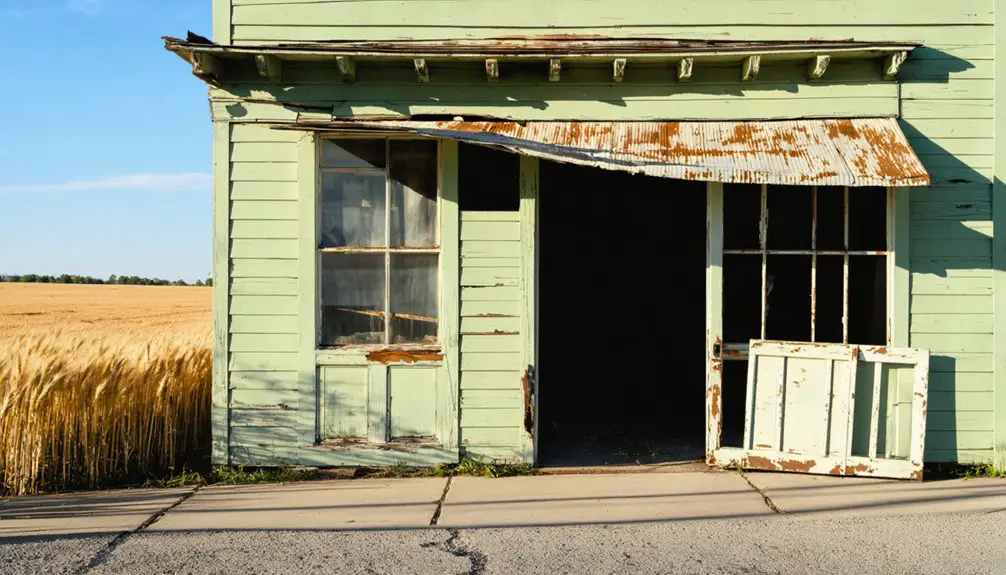You’ll find Bodum in east-central Minnesota’s Isanti County, where it briefly flourished as an agricultural settlement in the late 1800s. The community centered around essential buildings including a store, creamery, and ice house serving local dairy farmers. Despite the settlers’ self-sufficient approach, Bodum’s isolation from railroads and major roads limited its growth. After its post office closed in 1903, the settlement declined into a ghost town, though its converted general store still stands as a tribute to its pioneering past.
Key Takeaways
- Bodum was a small agricultural settlement in Isanti County, Minnesota that existed briefly in the late 19th century.
- The community’s isolation from railroads and major roads severely limited its growth potential and led to its decline.
- Essential buildings included a general store, creamery, and ice house, with only the store building surviving today as a residence.
- The post office operated from 1899 to 1903, marking the settlement’s brief period of official recognition.
- Bodum’s decline was primarily due to the emergence of nearby towns with railroad connections that drew residents away.
Geographic Location and Landscape
Nestled in east-central Minnesota’s Isanti County, the ghost town of Bodum once occupied section 16 of Isanti Township at approximately 45.52°N latitude and 93.20°W longitude.
You’ll find this forgotten settlement north-northeast of Minneapolis, near the small communities of Crown and Oak Grove.
The site’s geographic features showcase the region’s characteristic flat to gently rolling terrain, shaped by glacial activity that left behind rich till soils.
The land use patterns reflect a mix of open farmland and scattered deciduous forest, with prairie grasses dotting the landscape. Modern GPS technology pinpoints the location using UTM coordinate 15T for precise mapping.
The town’s agricultural economy was supported by its creamery and icehouse operations during its brief existence from 1899 to 1903.
While there aren’t any major water bodies directly within Bodum’s boundaries, the surrounding area includes small creeks, wetlands, and ponds that were essential to early settlement and agricultural development.
The post-glacial topography continues to influence local drainage patterns today.
Early Settlement and Establishment
During the late 19th century, pioneer farming families established Bodum as a small agricultural settlement, constructing essential community buildings including a store, creamery, and ice house.
You’ll find that these early settlers faced significant settlement challenges, as they built their homesteads without the advantage of railroad connections or major roadways.
Much like many early river towns, Bodum struggled with transportation and trade limitations that hindered its economic development.
Despite their isolation, the community’s resilience showed in their self-sufficient approach to survival. They relied heavily on local resources, with the creamery processing dairy products from nearby farms and the ice house preserving their food supplies. Much like the Danish-Swiss manufacturer Bodum, which started as a small family business in 1944, the settlement demonstrated remarkable entrepreneurial spirit.
The settlement gained formal recognition when its post office opened in 1899, though this service lasted only until 1903.
While the pioneers created a tight-knit farming community, Bodum’s remote location ultimately limited its growth and longevity.
Post Office Operations (1899-1903)
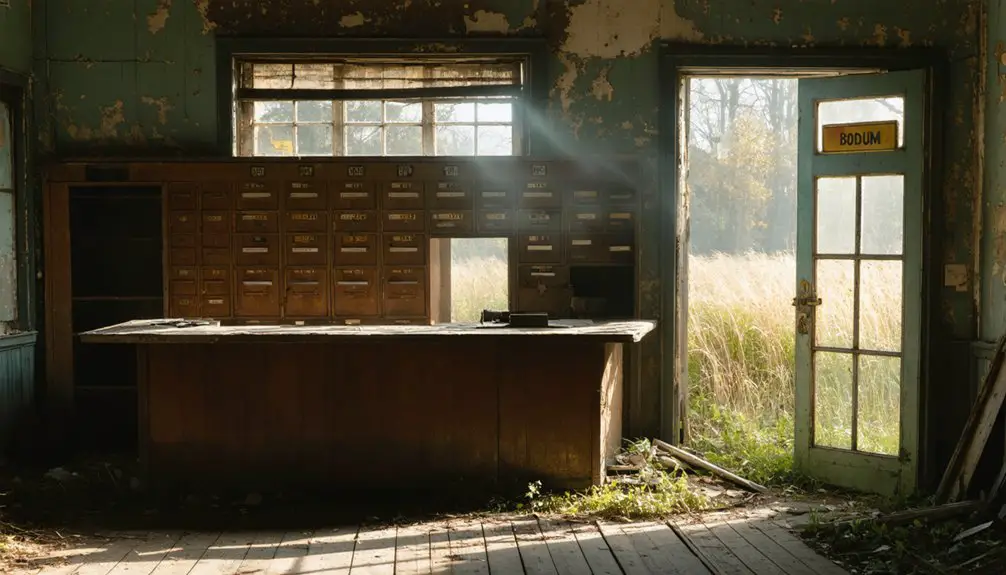
You’ll find the Bodum post office played a critical role in connecting the settlement to Minnesota’s broader postal network during its four-year operation from 1899 to 1903.
The facility handled both incoming and outgoing mail under the direction of locally appointed postmasters, whose appointment records were maintained by the Post Office Department’s national oversight system. Like many small post offices of the era, the postmaster likely used a manuscript cancel to mark outgoing mail.
Mail service operations included the distribution of correspondence, management of undeliverable items, and coordination with regional postal routes that linked Bodum’s residents to the outside world.
Mail Service Operations
The small post office of Bodum opened its doors in 1899, serving as a significant communication hub for this Minnesota settlement during its brief four-year existence.
You’d find the post office handling essential mail delivery services, processing everything from personal letters to business parcels that connected the isolated town to the wider world.
Operating from what was likely a local business or private residence, the postmaster managed mail manually using basic cancelling devices and relied on regional transportation routes.
The post office fostered critical community connection through its role as a centralized communication point, supporting commerce and news flow between Bodum’s inhabitants and other Minnesota communities.
When the office closed in 1903, it marked a turning point in Bodum’s decline, ultimately contributing to its shift into ghost town status.
Postmaster Personnel Records
Records of Bodum’s postmasters exist within Record Group 28 of the Post Office Department‘s national archives, documenting the town’s brief postal operations from 1899 to 1903.
You’ll find these records contain appointment dates and postmaster names, though exact service durations often remain unclear due to missing termination dates. The Office of the Chief Clerk oversaw postmaster appointments during this period, maintaining personnel files that included correspondence and official orders.
The documentation system followed standards established by the Post Office Act of 1872, tracking appointments through chronological lists and administrative journals.
While you can trace postmaster successions through appointment records, determining precise lengths of service requires examining the gaps between appointments.
These records also capture operational changes and office relocations that affected Bodum’s postal service during its short existence.
Local Business and Commerce
During its brief period of economic activity, Bodum maintained a modest commercial presence centered around essential agricultural services.
You’d find a general store supplying local goods, a creamery processing dairy products, and an ice house for food preservation. These businesses primarily served the farming community’s basic needs. The store stocked items similar to those found in Danish kitchenware manufacturer Bodum’s early product lines. Like Nininger’s decline, the town suffered from financial instability that limited growth potential.
Local commerce faced significant challenges due to Bodum’s isolation from major transportation routes.
Without railroad access or substantial roads, the town couldn’t expand its economic reach beyond the immediate area. The post office’s short operation from 1899 to 1903 reflects these limitations on growth.
Today, only the original store building remains, converted into a private residence.
This sole survivor of Bodum’s commercial past stands as a monument to the town’s brief role as a small agricultural trading center.
Agricultural Heritage and Farming Life
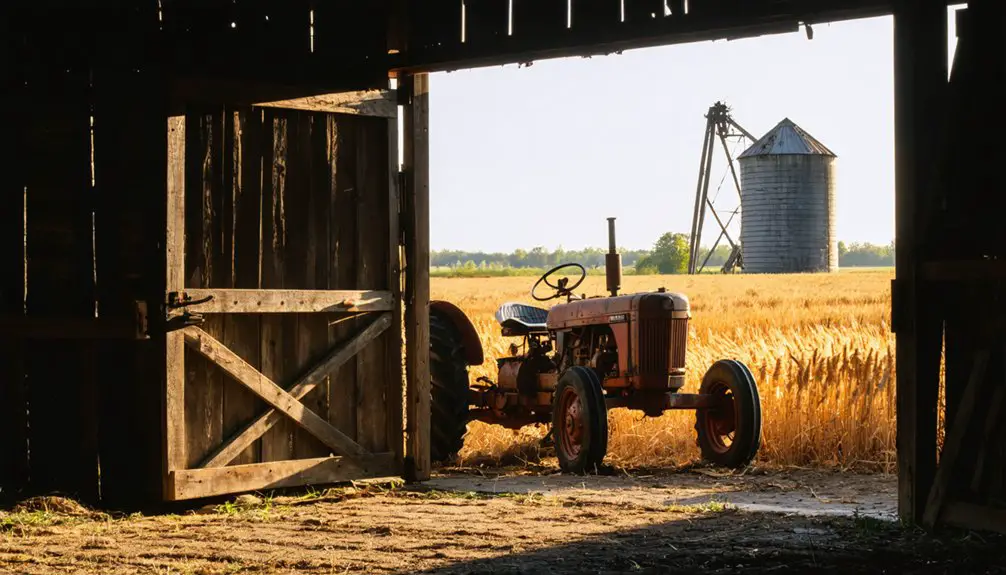
The agricultural heartbeat of Bodum centered on its local creamery, where you’d find farmers bringing their dairy products for processing and distribution throughout Isanti County.
You’ll notice the town’s farming infrastructure developed to support both crop and dairy operations, with the ice house playing an essential role in preserving dairy products before modern refrigeration.
The establishment of these agricultural facilities in the late 19th century reflected the region’s shift from wheat monoculture to more diversified farming practices, including an increased focus on dairy production. Like many Minnesota farms of the era, residents maintained small subsistence plots to provide food for their families and trade with neighbors.
Local Dairy Production Methods
As pioneering settlers established homesteads near Bodum in the mid-1800s, they brought dairy cattle to provide essential milk and butter for their families.
You’d find women handling most of the milking and cleaning duties in smaller herds, while larger operations required all hands on deck. Early dairy technology advancements, like cream separators, transformed how you’d process milk on the farm, making butter production more efficient than traditional hand-churning methods. The introduction of the Babcock milk test allowed farmers to accurately measure butterfat content and receive fair payment for their milk. Most farmers kept one to ten cows to ensure a steady supply of milk for their households.
Local creamery cooperatives emerged in the late 1800s, giving farmers a reliable market for their dairy products. By 1935, you’d find hundreds of these cooperative butter plants across Minnesota, including near Bodum.
The farms typically featured stall barns where you’d milk cows individually, though some operations used pen barns with separate milking parlors.
Farm Infrastructure Development
Building upon their dairy operations, Bodum’s settlers invested heavily in diverse farm infrastructure throughout the 1800s. You’d have found essential structures like barns, granaries, and ice houses dotting the landscape, supporting both crop storage and dairy preservation.
The community’s creamery served as a crucial hub for local farmers, while the general store provided necessary supplies for their operations.
As farm machinery evolved, you would’ve seen the transformation from simple claim shacks to more sophisticated farmsteads. Labor dynamics shaped the development of worker housing, with some farms adding dormitories and cottages to accommodate seasonal help.
Without railroad access, Bodum’s farmers adapted by creating self-sufficient infrastructure systems, including irrigation networks and erosion controls to maintain their land’s productivity in this isolated setting.
Transportation and Infrastructure Challenges
While many Minnesota towns flourished with the arrival of railroads in the late 19th century, Bodum’s isolation from major transportation networks severely limited its growth potential.
You wouldn’t have found rail lines, major roads, or reliable transportation alternatives connecting Bodum to larger markets. The town’s basic amenities – a post office, store, creamery, and ice house – couldn’t compensate for the lack of essential infrastructure investment that neighboring communities enjoyed.
The rise of automobile and bus transport in the 20th century further isolated Bodum, as new roads and routes prioritized larger population centers.
Without proper transportation infrastructure, Bodum struggled to attract settlers, businesses, or outside investment. Its geographic location in rural farmland made infrastructure development costly and complex, ultimately contributing to its decline into a ghost town.
Community Decline and Abandonment
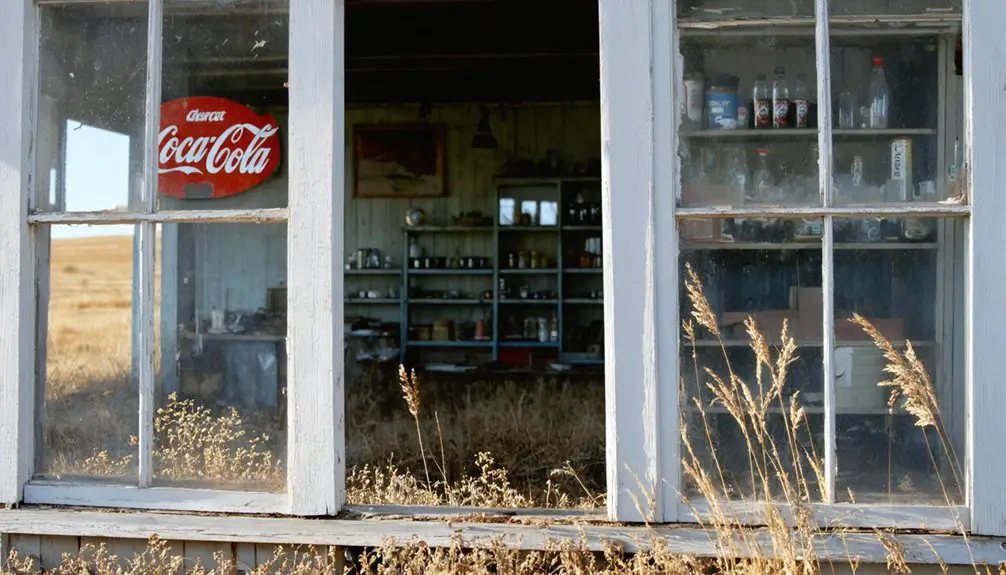
Despite initial hopes for growth and prosperity, Bodum’s community decline began in earnest during the late 1800s when nearby towns with railroad connections started drawing away residents and businesses.
You’ll find that economic stagnation took hold as the town struggled without major industries or transport links to sustain its population.
The closure of essential community institutions like the post office and general store marked critical turning points in Bodum’s abandonment.
Limited community engagement made it increasingly difficult to attract new settlers or investment, while families sold their properties at reduced prices to seek opportunities elsewhere.
The absence of a railroad connection proved particularly devastating, as you couldn’t effectively transport goods or attract commercial development, ultimately leading to Bodum’s transformation into another Minnesota ghost town.
Historical Buildings and Structures
Throughout its brief existence, Bodum’s architectural landscape reflected the modest needs of a small farming community, with the post office and general store serving as the settlement’s commercial heart from 1899 to 1903.
The store building, which still stands today as a private residence, represents the only surviving structure of historical significance.
A lone historic edifice endures in Bodum – the former general store, now serving as someone’s cherished home.
You’ll find that Bodum’s agricultural infrastructure once included a creamery and ice house, essential facilities that supported local dairy farming operations.
The architectural styles were purely functional, featuring simple wood-frame construction typical of rural Minnesota settlements.
Without railroad access, the town’s built environment remained limited.
While most original structures have vanished, the converted store building and possible archaeological remains of the creamery and ice house foundations offer glimpses into Bodum’s brief but notable past.
Legacy in Isanti County
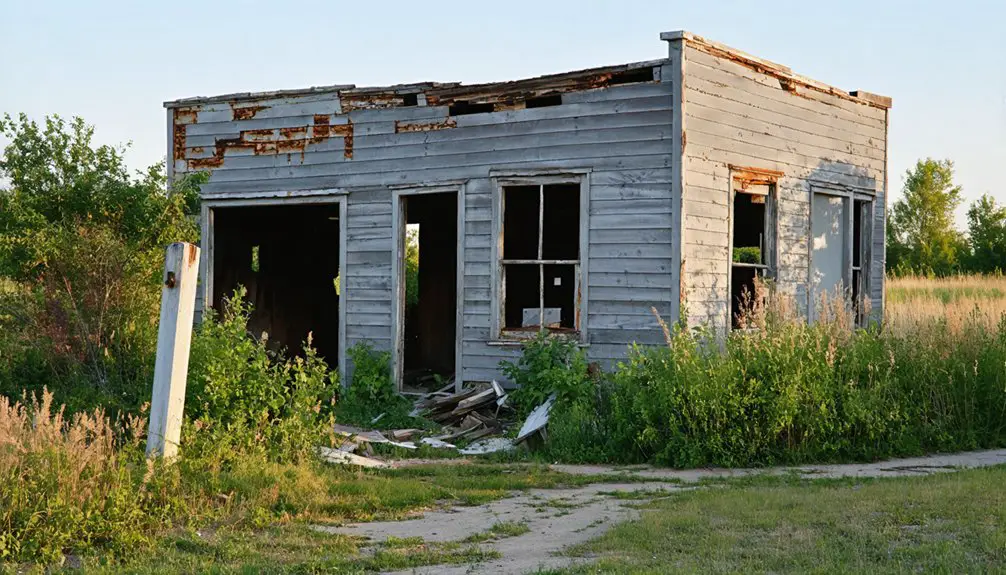
Bodum’s enduring impact on Isanti County extends far beyond its remaining structures.
You’ll find its influence woven into the region’s agricultural development, where the town’s creamery and ice house once supported local dairy farming operations.
The settlement patterns you can trace through Bodum’s history reveal how small farming communities adapted to geographical isolation and limited infrastructure.
Through cultural memory, Bodum serves as a reflection of rural Minnesota’s past, particularly in understanding how communities without railroad access often struggled to thrive.
While the post office only operated from 1899 to 1903, it established essential communication links that shaped early rural connectivity.
Today, Bodum’s legacy lives on in historical records, helping researchers and genealogists piece together the story of Isanti County’s agricultural heritage and settlement evolution.
Modern-Day Site Observations
When visiting the former townsite of Bodum today, you’ll find only one original structure still standing – the old store building that’s now been converted into a private residence.
The surrounding landscape remains largely agricultural, reflecting the area’s historical farming roots.
Fields and farmland stretch across the horizon, carrying on the agricultural legacy that defined Bodum from its earliest beginnings.
Site conditions vary seasonally, with winter snow often limiting accessibility.
You’ll need to navigate local township roads and obtain private land permissions to explore the area, as there’s no direct access via major roadways.
Current visitor experiences are quite different from typical ghost town encounters – you won’t find preserved ruins, historical markers, or tourism infrastructure here.
Instead, you’ll discover a quiet, rural setting near Lake Fanny and Cedar Creek Ecosystem Science Reserve, where the land’s primary use continues to be farming, much as it was in Bodum’s early days.
Frequently Asked Questions
What Was the Peak Population of Bodum During Its Brief Existence?
While exact Bodum demographics weren’t recorded, you’ll find the peak population likely didn’t exceed 100 residents before population decline set in, based on its limited infrastructure and short-lived post office operations.
Were There Any Notable Crimes or Incidents Reported in Bodum?
Like a blank page in history’s book, you won’t find any unsolved mysteries or local legends here. Historical records show no documented crimes or notable incidents during Bodum’s fleeting existence.
What Happened to the Families Who Originally Settled in Bodum?
The settler families moved to nearby towns with better infrastructure and opportunities. You’ll find their legacy merged into larger communities as they sought economic freedom beyond Bodum’s limited farming prospects.
Did Bodum Have a School or Church During Its Active Years?
You won’t find records of any Bodum schoolhouse or church establishment during its active years. The small farming community lacked these institutions, with residents likely traveling elsewhere for education and worship.
What Native American Tribes Previously Inhabited the Bodum Area?
Based on archaeological evidence, you’ll find the Dakota were primary inhabitants, with their culture deeply rooted there for centuries. Later, Ojibwe history shows their presence as they moved into northern Minnesota regions.
References
- https://en.wikipedia.org/wiki/Bodum
- https://www.wikiwand.com/en/articles/Bodum
- https://www.minnesotahistory.org/post/a-complete-guide-to-the-ghost-towns-of-hennepin-county
- https://en-academic.com/dic.nsf/ enwiki /7476926
- https://kids.kiddle.co/Bodum
- https://latitude.to/articles-by-country/us/united-states/182275/bodum-minnesota
- http://wikimapia.org/13645000/Bodum-MN-Ghost-Town
- https://latitude.to/map/us/united-states/cities/oak-grove-minnesota/articles/page/3
- https://gh.toponavi.com/181520
- https://mapcarta.com/22383400
